Catalog 171
All books are first printings of first editions or first American editions unless otherwise noted.
 1993. Photocopied typescript, 209 pages, and reproducing authorial corrections, of this memoir of the author's boyhood in Montana, covering the period prior by his award-winning first book, This House of Sky. Sent by the author, 7 months prior to publication, to the Mountain Plains Library Association (MPLA), with a typed note signed, dated February 10, 1993: "Quickest and surest just to send you a ph'copy of the Heart Earth manuscript for your MPLA review, instead of waiting on proofs. Here you go. Publication date is Sept." Followed by a typed note signed in October, when Doig is doing publicity for the book, transmitting a copy of the speech he made to the Colorado Library Association in Snowmass, adding, "The Snowmass audience was maybe my best ever." The speech is enlarged for reading to 45 legal-sized pages, with horizontal type. Doig has folded the first page so as to run it through a typewriter to add the title ("The American West as Heart Earth"), the place, and a copyright notice. Lastly, there is a transcript of a 9/13/2007 speech that Doig gave to the Loveland Loves to Read program. Enlarged for reading to 48 horizontal pages. Emphasis lines added in photocopy; several holograph corrections. The typescript and both speeches have been hole-punched so as to fit in a 3-ring binder; one of the legal pages is creased; else fine. The two speeches are apparently unpublished. This House of Sky was a National Book Award finalist, and Doig's series of memoirs and novels set in Montana, the Pacific Northwest, and Alaska led him be considered "a presiding figure in the literature of the American West" (critic Sven Birkerts) and to his receiving the lifetime Distinguished Achievement award from the Western Literature Association.
[#033875]
SOLD
1993. Photocopied typescript, 209 pages, and reproducing authorial corrections, of this memoir of the author's boyhood in Montana, covering the period prior by his award-winning first book, This House of Sky. Sent by the author, 7 months prior to publication, to the Mountain Plains Library Association (MPLA), with a typed note signed, dated February 10, 1993: "Quickest and surest just to send you a ph'copy of the Heart Earth manuscript for your MPLA review, instead of waiting on proofs. Here you go. Publication date is Sept." Followed by a typed note signed in October, when Doig is doing publicity for the book, transmitting a copy of the speech he made to the Colorado Library Association in Snowmass, adding, "The Snowmass audience was maybe my best ever." The speech is enlarged for reading to 45 legal-sized pages, with horizontal type. Doig has folded the first page so as to run it through a typewriter to add the title ("The American West as Heart Earth"), the place, and a copyright notice. Lastly, there is a transcript of a 9/13/2007 speech that Doig gave to the Loveland Loves to Read program. Enlarged for reading to 48 horizontal pages. Emphasis lines added in photocopy; several holograph corrections. The typescript and both speeches have been hole-punched so as to fit in a 3-ring binder; one of the legal pages is creased; else fine. The two speeches are apparently unpublished. This House of Sky was a National Book Award finalist, and Doig's series of memoirs and novels set in Montana, the Pacific Northwest, and Alaska led him be considered "a presiding figure in the literature of the American West" (critic Sven Birkerts) and to his receiving the lifetime Distinguished Achievement award from the Western Literature Association.
[#033875]
SOLD
 NY, Random House, (1952). His first book, winner of the National Book Award in 1953. A high spot of 20th century American literature -- both a classic of African-American fiction and a book that transcends such a racial identification to stand as a literary landmark on its own terms. In a poll conducted in 1965, 200 critics, authors and editors judged Invisible Man to be "the most distinguished single work" published in the previous 20 years. A fine copy in a very good dust jacket with minor rubbing, small edge chips, and splitting to the rear flap fold.
[#033914]
SOLD
NY, Random House, (1952). His first book, winner of the National Book Award in 1953. A high spot of 20th century American literature -- both a classic of African-American fiction and a book that transcends such a racial identification to stand as a literary landmark on its own terms. In a poll conducted in 1965, 200 critics, authors and editors judged Invisible Man to be "the most distinguished single work" published in the previous 20 years. A fine copy in a very good dust jacket with minor rubbing, small edge chips, and splitting to the rear flap fold.
[#033914]
SOLD
 London, Jonathan Cape, (1956). His fourth James Bond novel. Shallow dampstaining evident on lower boards; near fine in a very good dust jacket with minor rubbing to the edges and the folds and a small architectural drawing on the verso. In a custom, quarter leather clamshell case.
[#033623]
SOLD
London, Jonathan Cape, (1956). His fourth James Bond novel. Shallow dampstaining evident on lower boards; near fine in a very good dust jacket with minor rubbing to the edges and the folds and a small architectural drawing on the verso. In a custom, quarter leather clamshell case.
[#033623]
SOLD
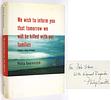 NY, Farrar Straus Giroux, (1998). A moving account of the 1994 Rwandan genocide. Winner of the National Book Critics Circle Award. This copy is inscribed by Gourevitch to the author Robert Stone: "For Bob Stone/ with warmest regards -- Philip Gourevitch." The rear jacket panel is entirely taken by a Stone blurb: "Young Philip Gourevitch brings us a report from the killing fields of Africa that marks him as a major successor to the handful of great correspondents who have risked life and safety to bring dark truths to a world reluctant to know of them. Like the greatest war reporters, he raises the human banner in hell's mouth, the insignia of common sense, of quiet moral authority, of blessed humor. He has the mind of a scholar along with the observative capacity of a good novelist, and he writes like an angel. This volume establishes him as the peer of Michael Herr, Ryszard Kapuscinski, and Tobias Wolff. I think there is no limit to what we may expect from him." Fine in a fine, if dusty, jacket.
[#033675]
SOLD
NY, Farrar Straus Giroux, (1998). A moving account of the 1994 Rwandan genocide. Winner of the National Book Critics Circle Award. This copy is inscribed by Gourevitch to the author Robert Stone: "For Bob Stone/ with warmest regards -- Philip Gourevitch." The rear jacket panel is entirely taken by a Stone blurb: "Young Philip Gourevitch brings us a report from the killing fields of Africa that marks him as a major successor to the handful of great correspondents who have risked life and safety to bring dark truths to a world reluctant to know of them. Like the greatest war reporters, he raises the human banner in hell's mouth, the insignia of common sense, of quiet moral authority, of blessed humor. He has the mind of a scholar along with the observative capacity of a good novelist, and he writes like an angel. This volume establishes him as the peer of Michael Herr, Ryszard Kapuscinski, and Tobias Wolff. I think there is no limit to what we may expect from him." Fine in a fine, if dusty, jacket.
[#033675]
SOLD
 NY, League of American Writers, [1941]. A three-paragraph statement by Hammett, part of a two-page mimeographed press release, written in his position as President of The League of American Writers and dated December 8 [1941], the day after Pearl Harbor. Hammett declares support for the U.S. declaration of war against Japan, and adds, "Our war is with the entire fascist Axis, not with one end of it. We therefore urge the immediate declaration of war against Germany and Italy and their satellites. Unwavering courage, a unified national will to win, and a complete understanding of the issues are needed. We call on all American writers to put their training, talent, and devotion to the service of our country." His call to action was published in New Masses on December 16, 1941, by which time the U.S. had already declared war on Germany and Italy. Hammett, a veteran of WWI, would re-enlist in the Army in 1942. A two-page press release, folded in thirds, with three annotations added by hand (date, suite number, alternate headline). Corner staple rusted; near fine. Other named officers include Theodore Dreiser, Erskine Caldwell, Meridel LeSueur, and Richard Wright. A little-known piece of writing by Hammett, who was both an accomplished mystery writer and screenwriter and also a committed political activist.
[#034447]
SOLD
NY, League of American Writers, [1941]. A three-paragraph statement by Hammett, part of a two-page mimeographed press release, written in his position as President of The League of American Writers and dated December 8 [1941], the day after Pearl Harbor. Hammett declares support for the U.S. declaration of war against Japan, and adds, "Our war is with the entire fascist Axis, not with one end of it. We therefore urge the immediate declaration of war against Germany and Italy and their satellites. Unwavering courage, a unified national will to win, and a complete understanding of the issues are needed. We call on all American writers to put their training, talent, and devotion to the service of our country." His call to action was published in New Masses on December 16, 1941, by which time the U.S. had already declared war on Germany and Italy. Hammett, a veteran of WWI, would re-enlist in the Army in 1942. A two-page press release, folded in thirds, with three annotations added by hand (date, suite number, alternate headline). Corner staple rusted; near fine. Other named officers include Theodore Dreiser, Erskine Caldwell, Meridel LeSueur, and Richard Wright. A little-known piece of writing by Hammett, who was both an accomplished mystery writer and screenwriter and also a committed political activist.
[#034447]
SOLD
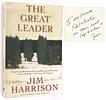 NY, Grove Press, (2011). The advance reading copy of Harrison's take on the detective story. Inscribed by Harrison to Philip Caputo and his wife, Leslie: "To my friends, Phil & Leslie on their road trip to where? Jim." In the year this book was published, the Caputos took a 16,000 mile road trip with truck and trailer from Key West, Florida, to Deadhorse, Alaska, resulting in Caputo's book The Longest Road: Overland in Search of America. Near fine in pictorial wrappers (and marked as an "uncorrected proof" by the publisher). An uncommon issue, and with a fine association between these two men, who were colleagues, neighbors, and friends.
[#033935]
SOLD
NY, Grove Press, (2011). The advance reading copy of Harrison's take on the detective story. Inscribed by Harrison to Philip Caputo and his wife, Leslie: "To my friends, Phil & Leslie on their road trip to where? Jim." In the year this book was published, the Caputos took a 16,000 mile road trip with truck and trailer from Key West, Florida, to Deadhorse, Alaska, resulting in Caputo's book The Longest Road: Overland in Search of America. Near fine in pictorial wrappers (and marked as an "uncorrected proof" by the publisher). An uncommon issue, and with a fine association between these two men, who were colleagues, neighbors, and friends.
[#033935]
SOLD
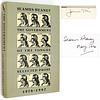 NY, Farrar Straus Giroux, (1989). Selected prose, 1978-1987. Signed by Heaney in May, 1990, and with the ownership signature of James Tate. Foxing to edges of text block; near fine in a fine dust jacket. A nice association.
[#033631]
SOLD
NY, Farrar Straus Giroux, (1989). Selected prose, 1978-1987. Signed by Heaney in May, 1990, and with the ownership signature of James Tate. Foxing to edges of text block; near fine in a fine dust jacket. A nice association.
[#033631]
SOLD
![click for a larger image of item #33917, Death and the Lover [Narcissus and Goldmund]](/static/images/kl/033917tn.jpg) NY, Dodd, Mead, (1932). The first English translation of one of Hesse's major novels, which chronicles the unlikely, but ultimately complementary, friendship between a monastic ascetic and a sensual existentialist who is determined to live life to the fullest. Owner name and address stamped on both flyleafs, the final page of text, and the top and bottom edges of the text block; text block pulling from binding; cup ring to rear board; a good copy, lacking the dust jacket. An uncommon edition of what was considered, at the time of its publication, the major work by this eventual Nobel Prize winner; a different translation of this novel was published in 1968 as Narcisssus and Goldmund.
[#033917]
SOLD
NY, Dodd, Mead, (1932). The first English translation of one of Hesse's major novels, which chronicles the unlikely, but ultimately complementary, friendship between a monastic ascetic and a sensual existentialist who is determined to live life to the fullest. Owner name and address stamped on both flyleafs, the final page of text, and the top and bottom edges of the text block; text block pulling from binding; cup ring to rear board; a good copy, lacking the dust jacket. An uncommon edition of what was considered, at the time of its publication, the major work by this eventual Nobel Prize winner; a different translation of this novel was published in 1968 as Narcisssus and Goldmund.
[#033917]
SOLD
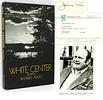 MY, Norton, (1980). A review copy of the hardcover issue. With the ownership signature of James Tate. Fine in a fine dust jacket with review slip and author photo laid in.
[#033632]
SOLD
MY, Norton, (1980). A review copy of the hardcover issue. With the ownership signature of James Tate. Fine in a fine dust jacket with review slip and author photo laid in.
[#033632]
SOLD
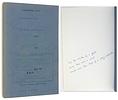 NY, Farrar Straus, (1992). The uncorrected proof copy of Johnson's collection of linked stories exploring addiction; this copy was used by James McManus for his review in the New York Times and bears extensive markings and comments. Among other things, McManus wrote: "has the rhythm of a poem/ more than even a novel/ much more than that of a short story collection." Johnson won the National Book Award for his massive Vietnam novel, Tree of Smoke, but it is this title that is widely considered his most powerful and emblematic. Near fine in wrappers.
[#033922]
SOLD
NY, Farrar Straus, (1992). The uncorrected proof copy of Johnson's collection of linked stories exploring addiction; this copy was used by James McManus for his review in the New York Times and bears extensive markings and comments. Among other things, McManus wrote: "has the rhythm of a poem/ more than even a novel/ much more than that of a short story collection." Johnson won the National Book Award for his massive Vietnam novel, Tree of Smoke, but it is this title that is widely considered his most powerful and emblematic. Near fine in wrappers.
[#033922]
SOLD
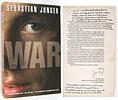 NY, Twelve, (2010). The advance reading copy of Junger's account of 15 months with the troops in eastern Afghanistan. This copy belonged to Philip Caputo and bears his highlighting and his comments in the margins. Caputo reviewed the book for the Washington Post. Page corners turned by Caputo; very good in wrappers.
[#033938]
SOLD
NY, Twelve, (2010). The advance reading copy of Junger's account of 15 months with the troops in eastern Afghanistan. This copy belonged to Philip Caputo and bears his highlighting and his comments in the margins. Caputo reviewed the book for the Washington Post. Page corners turned by Caputo; very good in wrappers.
[#033938]
SOLD
 NY, Twelve, (2016). The uncorrected proof copy of Junger's study of societal belonging, particularly as it pertains to veterans returning from war. This copy belonged to Philip Caputo and bears his underlining and his comments in the margins. Caputo reviewed the book for the Washington Post. Page corners turned by Caputo, else near fine in wrappers.
[#033939]
SOLD
NY, Twelve, (2016). The uncorrected proof copy of Junger's study of societal belonging, particularly as it pertains to veterans returning from war. This copy belonged to Philip Caputo and bears his underlining and his comments in the margins. Caputo reviewed the book for the Washington Post. Page corners turned by Caputo, else near fine in wrappers.
[#033939]
SOLD
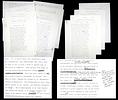 (n.p.), (n.p.), (1988-1991). Thirteen typescript "blurbs" by Pauline Kael -- her own condensations of her full-length reviews, re-written for the "Goings On About Town" section of The New Yorker in subsequent weeks. Most are a full page long and bear her small or not-so-small holograph changes, written in pencil. One is a photocopy, with the changes also photocopied. Included are several films that Kael panned, including The Godfather Part III and Dances With Wolves, for which she had to distill her long, thoughtful (and sometimes scathing) critiques into far fewer sentences. Films included, in addition to the two mentioned above, are: Sleeping With the Enemy; Awakenings; L.A. Story; The Bonfire of the Vanities [photocopy]; Edward Scissorhands; The Sheltering Sky; The Grifters; Rodrigo D: No Future; Tune in Tomorrow; Reversal of Fortune; and Vincent & Theo. 13 blurbs, totaling 15 sheets. A bit of age-spotting to the paper, and rust offset from paperclips; very good or better. Manuscript material by Kael is scarce: even her full-length reviews did not, for the most part, remain in her archive -- when she sent them off to The New Yorker, they never came back to her.
[#034588]
SOLD
(n.p.), (n.p.), (1988-1991). Thirteen typescript "blurbs" by Pauline Kael -- her own condensations of her full-length reviews, re-written for the "Goings On About Town" section of The New Yorker in subsequent weeks. Most are a full page long and bear her small or not-so-small holograph changes, written in pencil. One is a photocopy, with the changes also photocopied. Included are several films that Kael panned, including The Godfather Part III and Dances With Wolves, for which she had to distill her long, thoughtful (and sometimes scathing) critiques into far fewer sentences. Films included, in addition to the two mentioned above, are: Sleeping With the Enemy; Awakenings; L.A. Story; The Bonfire of the Vanities [photocopy]; Edward Scissorhands; The Sheltering Sky; The Grifters; Rodrigo D: No Future; Tune in Tomorrow; Reversal of Fortune; and Vincent & Theo. 13 blurbs, totaling 15 sheets. A bit of age-spotting to the paper, and rust offset from paperclips; very good or better. Manuscript material by Kael is scarce: even her full-length reviews did not, for the most part, remain in her archive -- when she sent them off to The New Yorker, they never came back to her.
[#034588]
SOLD
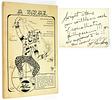 Pleasant Hill, Intrepid Trips, (1974). The first issue of Kesey's homegrown magazine, edited by him and with contributions by Kesey himself, Ken Babbs, Wendell Berry, Paul Krassner and others, including Kesey's alter-ego "Grandma Whittier." This is the scarce first printing, with no writing on the spine. Inscribed by Kesey to Robert Stone: "Awright Stone/ you worthless sack of sociallistic [sic] psallipsisms [sic] !!! You were supposed to be in this issue -30 - Ken Kesey." (-30- being used to connote "end of story.") Hand-addressed (then corrected) mailing label for Stone on rear cover; about near fine in wrappers. Stone and Kesey had a longtime friendship, going back to their time at Stanford in the early 1960s, where both were in Wallace Stegner's writing workshop. Stone went to Mexico to visit Kesey and write about his circumstances when Kesey fled the U.S. after a drug bust, and they stayed friends until Kesey died in 2001.
[#033739]
SOLD
Pleasant Hill, Intrepid Trips, (1974). The first issue of Kesey's homegrown magazine, edited by him and with contributions by Kesey himself, Ken Babbs, Wendell Berry, Paul Krassner and others, including Kesey's alter-ego "Grandma Whittier." This is the scarce first printing, with no writing on the spine. Inscribed by Kesey to Robert Stone: "Awright Stone/ you worthless sack of sociallistic [sic] psallipsisms [sic] !!! You were supposed to be in this issue -30 - Ken Kesey." (-30- being used to connote "end of story.") Hand-addressed (then corrected) mailing label for Stone on rear cover; about near fine in wrappers. Stone and Kesey had a longtime friendship, going back to their time at Stanford in the early 1960s, where both were in Wallace Stegner's writing workshop. Stone went to Mexico to visit Kesey and write about his circumstances when Kesey fled the U.S. after a drug bust, and they stayed friends until Kesey died in 2001.
[#033739]
SOLD
 Bronxville, Sarah Lawrence College, 1943. Two poems by Kizer, "So Speak" and ""I Dreamed I Was Saint Augustine," in this publication by the English Department of Sarah Lawrence College, designated as being "For Classroom Use." Kizer would have been a 17 year-old sophomore at the time: three months later she would have a poem ("When You Are Distant") published in The New Yorker. Her first book was not published until 16 years later. Modest spotting and sunning; very good in stapled wrappers. Uncommon.
[#033636]
SOLD
Bronxville, Sarah Lawrence College, 1943. Two poems by Kizer, "So Speak" and ""I Dreamed I Was Saint Augustine," in this publication by the English Department of Sarah Lawrence College, designated as being "For Classroom Use." Kizer would have been a 17 year-old sophomore at the time: three months later she would have a poem ("When You Are Distant") published in The New Yorker. Her first book was not published until 16 years later. Modest spotting and sunning; very good in stapled wrappers. Uncommon.
[#033636]
SOLD
 NY, Holt Rinehart Winston, (1974). The author's own copy of this book of cultural and literary criticism. Signed by Krim prior to publication, with a Village Voice ad tipped in, beneath a quotation from Sir Kenneth Clark that is handwritten by Krim, and with more than two dozen pages marked by Krim with changes or corrections, beginning with a re-ordering of the pieces in the Table of Contents. Krim was one of the preeminent essayists of his time, writing about the Beats, the New York cultural scene in the 1950s, the counterculture, and more. This volume has blurbs or review excerpts by James Baldwin, Norman Mailer, William Styron, John Clellon Homes, Dan Wakefield, and others. Laid in is an obituary for Big Joe Turner, who is featured in a chapter in the book. Handled: a good copy in a good dust jacket. Unique.
[#033637]
SOLD
NY, Holt Rinehart Winston, (1974). The author's own copy of this book of cultural and literary criticism. Signed by Krim prior to publication, with a Village Voice ad tipped in, beneath a quotation from Sir Kenneth Clark that is handwritten by Krim, and with more than two dozen pages marked by Krim with changes or corrections, beginning with a re-ordering of the pieces in the Table of Contents. Krim was one of the preeminent essayists of his time, writing about the Beats, the New York cultural scene in the 1950s, the counterculture, and more. This volume has blurbs or review excerpts by James Baldwin, Norman Mailer, William Styron, John Clellon Homes, Dan Wakefield, and others. Laid in is an obituary for Big Joe Turner, who is featured in a chapter in the book. Handled: a good copy in a good dust jacket. Unique.
[#033637]
SOLD
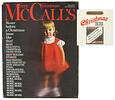 (Dayton), McCall's, 1961. Lee, writing the year she won the Pulitzer Prize for To Kill a Mockingbird, tells the story of the act of love from two friends [Michael and Joy Brown] that had given her the freedom to quit her job working for an airline in New York City and to write for one year -- or, as she puts it, "a full, fair chance at a new life." Wear to the spine and edges of the covers; very good. Other than her famous first novel, Harper Lee's appearances in print over the years have been few and far between.
[#033638]
SOLD
(Dayton), McCall's, 1961. Lee, writing the year she won the Pulitzer Prize for To Kill a Mockingbird, tells the story of the act of love from two friends [Michael and Joy Brown] that had given her the freedom to quit her job working for an airline in New York City and to write for one year -- or, as she puts it, "a full, fair chance at a new life." Wear to the spine and edges of the covers; very good. Other than her famous first novel, Harper Lee's appearances in print over the years have been few and far between.
[#033638]
SOLD
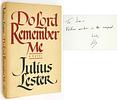 NY, Holt Rinehart, (1984). A novel by the African-American writer and photographer, a former civil rights activist in the 1960s. Inscribed by Lester to poet James Tate: "To Jim - Fellow worker in the vineyard. Love, Julius." From the estate of James Tate. Fine in a near fine dust jacket.
[#033639]
SOLD
NY, Holt Rinehart, (1984). A novel by the African-American writer and photographer, a former civil rights activist in the 1960s. Inscribed by Lester to poet James Tate: "To Jim - Fellow worker in the vineyard. Love, Julius." From the estate of James Tate. Fine in a near fine dust jacket.
[#033639]
SOLD
 [Iowa City], Self-Published, 1977. Apparently the author's first book, a limited edition that Cherry both wrote and illustrated, about the close relationship of Theo and Vincent van Gogh, self-published while she was a student at the University of Iowa. This is copy 11 of 35 copies, and is inscribed by the author: "To the Wagners -- Your friendship was one of the highlights of Quincy. With love, Kit." Cherry became a minister to the LGBT community in the Los Angeles area and wrote several books with gay, lesbian, and religious themes. A small volume: 5-1/2" x 6" and 15 pages. Rubbing and handling evident to blue cloth boards; very good, without dust jacket, presumably as issued. No copies located in OCLC.
[#033895]
SOLD
[Iowa City], Self-Published, 1977. Apparently the author's first book, a limited edition that Cherry both wrote and illustrated, about the close relationship of Theo and Vincent van Gogh, self-published while she was a student at the University of Iowa. This is copy 11 of 35 copies, and is inscribed by the author: "To the Wagners -- Your friendship was one of the highlights of Quincy. With love, Kit." Cherry became a minister to the LGBT community in the Los Angeles area and wrote several books with gay, lesbian, and religious themes. A small volume: 5-1/2" x 6" and 15 pages. Rubbing and handling evident to blue cloth boards; very good, without dust jacket, presumably as issued. No copies located in OCLC.
[#033895]
SOLD
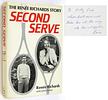 NY, Stein and Day, (1983). The autobiography (written with John Ames) of tennis player Renee Richards, who was born Richard Raskin, transitioned from male to female in the mid-1970s, and successfully sued the U.S. Tennis Association to be able to play in the U.S. Open. In 1977, at age 43, Richards made it to the women's doubles final, losing to a pair that included Martina Navratilova, whom she herself would later coach. Inscribed by Richards to another tennis player, "whose first serve will take her all the way, with love and affection, Renee." One of the first high-profile cases of transgender identity in the U.S. Corners lightly tapped; near fine in a near fine dust jacket with a bit of edge-sunning and a shallow crimp at the crown. Uncommon signed.
[#033903]
SOLD
NY, Stein and Day, (1983). The autobiography (written with John Ames) of tennis player Renee Richards, who was born Richard Raskin, transitioned from male to female in the mid-1970s, and successfully sued the U.S. Tennis Association to be able to play in the U.S. Open. In 1977, at age 43, Richards made it to the women's doubles final, losing to a pair that included Martina Navratilova, whom she herself would later coach. Inscribed by Richards to another tennis player, "whose first serve will take her all the way, with love and affection, Renee." One of the first high-profile cases of transgender identity in the U.S. Corners lightly tapped; near fine in a near fine dust jacket with a bit of edge-sunning and a shallow crimp at the crown. Uncommon signed.
[#033903]
SOLD
 NY, Knopf, 1998. The uncorrected proof copy, from the author's own library, of perhaps his most personal book. Essays on place and perspective, with the author's sense of engagement with the world reflected in the reasons he gives for foregoing photography for writing: "I don't want to stop and focus on a fixed image, which I'm inclined to do as a photographer. I want, instead, to see a sentence fragment scrawled in my notebook, smeared by rain." Lopez does not, as a matter of principle, sign advance copies, but this proof comes with a typed note signed by Lopez attesting to the fact that it is from his personal library. Fine in wrappers.
[#034455]
SOLD
NY, Knopf, 1998. The uncorrected proof copy, from the author's own library, of perhaps his most personal book. Essays on place and perspective, with the author's sense of engagement with the world reflected in the reasons he gives for foregoing photography for writing: "I don't want to stop and focus on a fixed image, which I'm inclined to do as a photographer. I want, instead, to see a sentence fragment scrawled in my notebook, smeared by rain." Lopez does not, as a matter of principle, sign advance copies, but this proof comes with a typed note signed by Lopez attesting to the fact that it is from his personal library. Fine in wrappers.
[#034455]
SOLD
 Homestead, Olivant Press, (1968). The second volume of "My Many Lives: the Autobiography of Walter Lowenfels." Lowenfels was a poet, editor, journalist, and left-wing political activist. He was arrested by the FBI in 1953 for conspiracy to overthrow the government; in the 1960s he was a prominent anti-Vietnam-war activist; in 1975 he edited an international anthology, For Neruda, For Chile, in the aftermath of the 1973 Chilean coup. An uncommon publication, produced from typescript. OCLC locates only three copies. Very good in a very good dust jacket that is too short for the book and has an edge tear on the lower rear panel.
[#034458]
SOLD
Homestead, Olivant Press, (1968). The second volume of "My Many Lives: the Autobiography of Walter Lowenfels." Lowenfels was a poet, editor, journalist, and left-wing political activist. He was arrested by the FBI in 1953 for conspiracy to overthrow the government; in the 1960s he was a prominent anti-Vietnam-war activist; in 1975 he edited an international anthology, For Neruda, For Chile, in the aftermath of the 1973 Chilean coup. An uncommon publication, produced from typescript. OCLC locates only three copies. Very good in a very good dust jacket that is too short for the book and has an edge tear on the lower rear panel.
[#034458]
SOLD
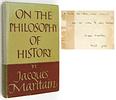 NY, Scribner's, (1957). Warmly inscribed by the author, in French, to Doris Dana, "To our very dear friend Doris with our most tender wishes," in 1958. In addition to being Maritain's close friend, Dana was a friend of Thomas Merton, and the friend and editor of Gabriela Mistral, the first Latin American writer to receive the Nobel Prize for Literature. Offsetting to endpages and dampstaining to foredge and covers; a fair copy in a fair, dampstained dust jacket now adhered to the book.
[#033642]
SOLD
NY, Scribner's, (1957). Warmly inscribed by the author, in French, to Doris Dana, "To our very dear friend Doris with our most tender wishes," in 1958. In addition to being Maritain's close friend, Dana was a friend of Thomas Merton, and the friend and editor of Gabriela Mistral, the first Latin American writer to receive the Nobel Prize for Literature. Offsetting to endpages and dampstaining to foredge and covers; a fair copy in a fair, dampstained dust jacket now adhered to the book.
[#033642]
SOLD

A small archive (three boxes) of a book that documents two American decades in one of New York City's signature neighborhoods: Stuyvesant Town.
Corinne Demas is a novelist and author of young adult books who grew up in Stuyvesant Town as one of the first generation to live in the development, which opened in 1947. In 2000, Demas published a memoir of her childhood and adolescence entitled "Eleven Stories High: Growing Up in Stuyvesant Town, 1948-1968." SUNY Press issued the book, and this archive chronicles its creation and publication and the response it engendered, as well as the issues surrounding Stuyvesant Town.
Stuyvesant Town was conceived as a carefully planned postwar middle class neighborhood in central Manhattan. Prospective tenants were closely screened and their income verified. The number of applicants for the 11,000 apartments comprising Stuyvesant Town, and the slightly more upscale Peter Cooper Village, totaled more than 100,000. ST-PCV was an experiment in urban planning – a gated community in the heart of the city, privately owned, with private roads, and a private security force – and also an experiment in social engineering: blacks were excluded in its early years and the income requirements kept out the poor. The apartment buildings clustered around a central oval with a fountain; traffic was limited; there were no schools or shops. The development was designed to be a safe haven from the rest of the city, and in that it eventually succeeded: by the 1980s it was deemed the safest neighborhood in New York City.
Many of the early residents were young families, often from working class backgrounds, many of them immigrants or the children of immigrants. Stuyvesant Town represented a step up the social ladder, into the middle class, with higher incomes, better education for the children, less onerous working conditions for the fathers, and mothers who could stay at home as housewives. Much of what we still associate with the term "middle class" was established, defined, and nurtured in the early postwar years in Stuyvesant Town, as was a significant portion of what we call "the American Dream" – the belief that one's children's future should be brighter than their parents', their education greater, their opportunities more, and that this should continue indefinitely.
Demas' book documents the first generation's years in Stuyvesant Town. From the author's website:
Eleven Stories High is a memoir of my middle class New York childhood, and the particular perceptions of a girl growing up in a housing project where the apartments and buildings are identical and you're prohibited from walking on the grass. It is an exploration of the concept of "home," how a place like Stuyvesant Town—impersonal, symmetrical, utilitarian—shapes a childhood. Eleven Stories High is organized by subject (rather than chronology), and examines aspects of my life in Stuyvesant Town from the time I was a toddler till I was a teenager at all-girls Hunter High School. I talk about elevators, telephones, subways, and parakeets.
Chapter topics include Hunter Elementary School and the education of the supposedly "intellectually gifted child," being a Gentile in a Jewish world, the secret community of Greeks in America, and the contrast between "the country" (Mt. Kisco, New York) and the vast sterility of Stuyvesant Town where an earthworm was an exotic, a butterfly a miracle.
I write about my grandfather (who was head of the Dead Letter Department for the U.S. Post Office in New York), my father (an unconventional dentist) and his encounters with armed robbers, and my mother, who performed all the tasks of a traditional Fifties housewife in addition to being a biology teacher at Stuyvesant High School (where she taught the boys I met at school dances everything they knew about reproduction).
This book is particularly concerned with the changing roles and expectations of women between my mother's generation and mine.
This archive contains Demas' scrapbook of her school years (featuring a note signed by Eleanor Roosevelt); multiple manuscript drafts of the memoir (both hard copies and digital copies); and publication material and related correspondence (with two publishers). In addition: when Eleven Stories High was published, Demas became an inadvertent spokesperson for Stuyvesant Town, and her comments on various ST-related matters – having to do with real estate values in the late 1990s and early 2000s, the gentrification of ST-PCV, the decline of the middle class, and the contrast with the values instilled by her upbringing in this "accidental utopia," as she called it – appeared in the New York Times as an article, an op-ed piece, and a letter to the editor. The archive contains her writings for the Times on these subjects as well as a sizable amount of the correspondence it generated. Moreover, the book itself generated several large files of correspondence: included here are hundreds of pages of readers sharing their responses to the book and their own recollections of Stuyvesant Town. The book is a memoir but the archive is, in effect, a social history.
Little else has been written about Stuyvesant Town. The 2013 book Other People's Money by Charles Bagli focused on Stuyvesant Town and Peter Cooper Village as the center of the greatest real estate deal ever made – and, at the height of the Great Recession, ever to fail. But little has been written about the community itself, which helped give rise to the idea of gated communities around the country, helped to define what it meant to be in the middle class at that time, especially in an urban area, and embodied so many elements of both the positive and negative aspects of "the American Dream." Demas' memoir touches on issues of class, race, religion and gender.
A full inventory is available on request.
[#033849] $9,500 Paris, Obelisk Press, 1939. Miller's fourth book to be printed by Jack Kahane's Obelisk Press in Paris, which had also published Tropic of Cancer as well as work by such writers as Anais Nin, James Joyce, Cyril Connolly, Lawrence Durrell, and others. This is a variant unrecorded by Miller's bibliographers, with the sheets of the variant first edition (Shifreen & Jackson A21b) and the binding conforming to such on all points but for a "175 00" price stamped on the back wrapper and no price on the spine. Small edge and corner tears, crease on the rear cover; near fine in wrappers. Tropic of Capricorn, like Tropic of Cancer, could not be published in the U.S. until nearly three decades after this edition because of its frank depiction of sexual matters, but it wielded an enormous influence from afar, and helped usher in a new era of literature, in which traditional barriers to the artist's self-expression were abandoned.
[#029263]
SOLD
Paris, Obelisk Press, 1939. Miller's fourth book to be printed by Jack Kahane's Obelisk Press in Paris, which had also published Tropic of Cancer as well as work by such writers as Anais Nin, James Joyce, Cyril Connolly, Lawrence Durrell, and others. This is a variant unrecorded by Miller's bibliographers, with the sheets of the variant first edition (Shifreen & Jackson A21b) and the binding conforming to such on all points but for a "175 00" price stamped on the back wrapper and no price on the spine. Small edge and corner tears, crease on the rear cover; near fine in wrappers. Tropic of Capricorn, like Tropic of Cancer, could not be published in the U.S. until nearly three decades after this edition because of its frank depiction of sexual matters, but it wielded an enormous influence from afar, and helped usher in a new era of literature, in which traditional barriers to the artist's self-expression were abandoned.
[#029263]
SOLD
 1958. An autograph letter signed from Miller to editor and publisher Pascal (Pat) Covici, regarding R.K. Narayan's book The Guide. A full page, plus one margin, of Miller's writing in pencil, praising Narayan's book and asking about others. Two passages are bracketed in red, presumably by Covici, and marked "excerpt." In the second of these, Miller writes, "I was amazed that a man of his world could exhibit such a modern technique. To boot, he's a born story teller. With a fine sense of the tragi-comic." Dated in Big Sur, 6/13/58. Another hand has added, "File H. Miller." Browned, else fine. Good literary content.
[#033645]
SOLD
1958. An autograph letter signed from Miller to editor and publisher Pascal (Pat) Covici, regarding R.K. Narayan's book The Guide. A full page, plus one margin, of Miller's writing in pencil, praising Narayan's book and asking about others. Two passages are bracketed in red, presumably by Covici, and marked "excerpt." In the second of these, Miller writes, "I was amazed that a man of his world could exhibit such a modern technique. To boot, he's a born story teller. With a fine sense of the tragi-comic." Dated in Big Sur, 6/13/58. Another hand has added, "File H. Miller." Browned, else fine. Good literary content.
[#033645]
SOLD
 London, Folio Society, 2015. The first illustrated edition of Morrison's 1987 novel, which won the Pulitzer Prize, was the basis for the award-winning 1998 film by Jonathan Demme, and was voted the Best Work of American Fiction in a quarter century in a 2006 survey by The New York Times Book Review. This edition has an introduction by Russell Banks and illustrations by Joe Morse. A fine copy in a fine slipcase; still shrinkwrapped.
[#034461]
SOLD
London, Folio Society, 2015. The first illustrated edition of Morrison's 1987 novel, which won the Pulitzer Prize, was the basis for the award-winning 1998 film by Jonathan Demme, and was voted the Best Work of American Fiction in a quarter century in a 2006 survey by The New York Times Book Review. This edition has an introduction by Russell Banks and illustrations by Joe Morse. A fine copy in a fine slipcase; still shrinkwrapped.
[#034461]
SOLD
 DeKalb, Cedar Creek, 1980. The uncorrected proof copy of the first book, a collection of poems, by this writer of Choctaw-English-Welsh descent. Printed on rectos only, apparently shot from paste up, with lines around text, faint copy-editing, and occasionally typos, evident. Bradbound plain blue covers, with typed label for title. Tape over rear brads. Name and address stamp on first blank. Near fine. The trade edition of this book is uncommon; the proof exceedingly so: we have never seen another copy.
[#033918]
SOLD
DeKalb, Cedar Creek, 1980. The uncorrected proof copy of the first book, a collection of poems, by this writer of Choctaw-English-Welsh descent. Printed on rectos only, apparently shot from paste up, with lines around text, faint copy-editing, and occasionally typos, evident. Bradbound plain blue covers, with typed label for title. Tape over rear brads. Name and address stamp on first blank. Near fine. The trade edition of this book is uncommon; the proof exceedingly so: we have never seen another copy.
[#033918]
SOLD
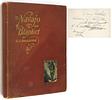 Denver, Self-Published, 1903. A self-published volume on the history and the qualities of the Navajo and of Navajo weaving, well-illustrated with black and white and color plates of blankets from the author's collection. This copy is inscribed by the author, Uriah Hollister, to his brother, Warren Hollister, in Denver, in the year of publication. Laid in is a postcard announcement on a talk to be given by the author at the Colorado Academy of Science on the subject, "Navajo Blankets, Their History and Symbolism," as well as a small square sample of "old bayeta," a square of Navajo weaving, in an envelope labeled as such, with the added notation "See Page 103," signed by Fanny Hollister Moore. Some general foxing throughout, with uneven wear to the cloth covers. One color plate loose, and some soiling and wear to covers; overall a good copy, without dust jacket, as issued.
[#033647]
SOLD
Denver, Self-Published, 1903. A self-published volume on the history and the qualities of the Navajo and of Navajo weaving, well-illustrated with black and white and color plates of blankets from the author's collection. This copy is inscribed by the author, Uriah Hollister, to his brother, Warren Hollister, in Denver, in the year of publication. Laid in is a postcard announcement on a talk to be given by the author at the Colorado Academy of Science on the subject, "Navajo Blankets, Their History and Symbolism," as well as a small square sample of "old bayeta," a square of Navajo weaving, in an envelope labeled as such, with the added notation "See Page 103," signed by Fanny Hollister Moore. Some general foxing throughout, with uneven wear to the cloth covers. One color plate loose, and some soiling and wear to covers; overall a good copy, without dust jacket, as issued.
[#033647]
SOLD
 NY, Harper & Row, (1979). The second novel by the acclaimed poet and novelist, who was one of the key figures in the first wave of what has been called the Native American Renaissance. Inscribed by Welch to award-winning poet James Tate and his wife: "For Jim and Lisa/ Here's a scary one for you, Love, Jim." Foxing to the edge of the text block, handled; about near fine in a very good, edgeworn dust jacket. A good association between two of the most highly regarded writers of their era. From the estate of James Tate.
[#033648]
SOLD
NY, Harper & Row, (1979). The second novel by the acclaimed poet and novelist, who was one of the key figures in the first wave of what has been called the Native American Renaissance. Inscribed by Welch to award-winning poet James Tate and his wife: "For Jim and Lisa/ Here's a scary one for you, Love, Jim." Foxing to the edge of the text block, handled; about near fine in a very good, edgeworn dust jacket. A good association between two of the most highly regarded writers of their era. From the estate of James Tate.
[#033648]
SOLD
